|
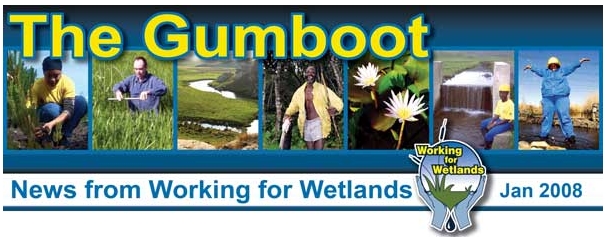
Remember
2nd February
This special edition of gumboot explains the vital links between healthy people and healthy wetlands.
Click here to download a PDF file of the Healthy wetlands, healthy people pamphlet
|
Healthy Wetlands, Healthy People
 The health and well-being of people is intricately linked to the state of their environment. For example, their exposure to water-borne diseases is reduced if they have a good, clean water supply - whether from taps or directly from rivers. There are many such benefits, or ecosystem services, that nature provides that are essential to human health and well-being. But to be able to provide these services, ecosystems need to be kept in a healthy condition. As an ecosystem becomes degraded, or less healthy, the services it supplies are usually reduced. Ecosystem services operate on such a vast scale and in such complex ways that most cannot be replaced by human technology. The health and well-being of people therefore depends on maintaining healthy ecosystems. The health and well-being of people is intricately linked to the state of their environment. For example, their exposure to water-borne diseases is reduced if they have a good, clean water supply - whether from taps or directly from rivers. There are many such benefits, or ecosystem services, that nature provides that are essential to human health and well-being. But to be able to provide these services, ecosystems need to be kept in a healthy condition. As an ecosystem becomes degraded, or less healthy, the services it supplies are usually reduced. Ecosystem services operate on such a vast scale and in such complex ways that most cannot be replaced by human technology. The health and well-being of people therefore depends on maintaining healthy ecosystems.
Wetlands are complex, fascinating and dynamic. They are hardworking ecosystems that provide us with a range of benefits, including some that are not immediately apparent. The National Wetland Inventory has mapped over 120,000 wetlands, ranging greatly in size and value and accounting for about 7% of South Africa's surface area. Different wetland types supply different ecosystem services including flood attenuation, provision of clean water, and carbon storage. Commonly referred to as marshes, swamps, bogs or vlei's, they support a range of specialised plant, insect, bird and mammal life and also supply wild food, grazing, building and craft materials to people.
 In providing these ecosystem services, healthy wetlands play an important role in keeping people healthy. If we protect healthy wetlands to keep them in a good condition, and rehabilitate those that have been degraded, we can avoid much suffering due to droughts, floods and compromised livelihoods, especially for the most vulnerable members of society. In providing these ecosystem services, healthy wetlands play an important role in keeping people healthy. If we protect healthy wetlands to keep them in a good condition, and rehabilitate those that have been degraded, we can avoid much suffering due to droughts, floods and compromised livelihoods, especially for the most vulnerable members of society.
|
|
Assessing Wetland Health
Because wetlands are at the interface of land and water, they are strongly connected to both terrestrial and aquatic ecosystems. Therefore, the health of a wetland is strongly affected by what is happening upstream. This means that an unhealthy wetland will often be a good indicator of problems in its catchment. Degradation in a wetland also affects downstream ecosystems.
 When we assess a person's health, we think of several interconnected systems - e.g. a skeleton and a circulatory system. So if we want to describe the health of a person, we assess how well each of these systems is performing. We can assess wetlands in the same way if we think of them as being made up of different systems. We can think of the geomorphological system - sand, clay and underlying rock - as the bones and muscles of the wetland. The hydrological system - the water - would be the circulatory system or lifeblood of the wetland. And the vegetation is the skin and hair protecting the wetland. We can assess each of these systems to determine the overall health of the wetland. We also need to ask what is causing the decline in a degraded wetland so that we can improve its condition in a way that addresses both the symptoms and the causes. When we assess a person's health, we think of several interconnected systems - e.g. a skeleton and a circulatory system. So if we want to describe the health of a person, we assess how well each of these systems is performing. We can assess wetlands in the same way if we think of them as being made up of different systems. We can think of the geomorphological system - sand, clay and underlying rock - as the bones and muscles of the wetland. The hydrological system - the water - would be the circulatory system or lifeblood of the wetland. And the vegetation is the skin and hair protecting the wetland. We can assess each of these systems to determine the overall health of the wetland. We also need to ask what is causing the decline in a degraded wetland so that we can improve its condition in a way that addresses both the symptoms and the causes.
|
|
Water from Wetlands
Wetlands play an important role in ensuring a steady supply of clean water, which is essential for human health. In areas where people use water directly from natural sources such as rivers, wetlands play a strong role in keeping people healthy. For those who get their water from taps, healthy wetlands in river systems contribute significantly to reducing the cost of purifying water.

Wetlands are uniquely designed to purify water through natural processes, acting like the kidneys of the landscape. Firstly, they slow down water flow and this allows sediments in the water to be deposited. Then, wetland plants, such as bulrushes and reeds, and wetland soils and microbes stabilise and store or use many pollutants including excess nutrients and toxins from sewage and agricultural chemicals and fertilisers. This helps reduce the possibility of eutrophication downstream. They can also trap many heavy metals including cadmium, zinc and mercury that result from mining and industrial processes. The roots of some plants secrete toxic substances that kill some pathogenic bacteria.
Wetlands also act like sponges, slowing down flood waters, storing water when it rains, and then releasing it slowly during the dry season, helping to ensure steady river flow. Special wetland soils such as peat are highly effective water stores and filters. Peat is able to hold 1,000 times its own weight in water, which makes it valuable in a semi-arid country like South Africa. Some wetlands also play a role in recharging groundwater.
As urbanisation increases, so does the pressure to provide adequate sanitation and water. South Africa's water resources are already well utilised and in many areas show signs of stress because of high demand. The answer to our looming water crisis does not lie only in complex and expensive engineering solutions. Nature provides robust and free technology, which we should recognise, respect and protect. Although wetlands are not the only solution for clean water, they are a key part of the answer.
|
|
Life in Wetlands
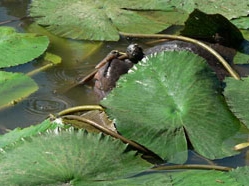 Wetlands are warehouses of biodiversity. They support plants and animals that are specially adapted to wetlands and can live nowhere else, and also provide feeding, roosting and breeding sites for a range of other species. Even in urban areas they are important refuges for small mammals, birds and amphibians. Wetlands are warehouses of biodiversity. They support plants and animals that are specially adapted to wetlands and can live nowhere else, and also provide feeding, roosting and breeding sites for a range of other species. Even in urban areas they are important refuges for small mammals, birds and amphibians.
South Africa has a dynamic climate and highly variable vegetation types which also means a great variety of wetland types, from shallow, temporary pans to flooded swamp forests. Each of these wetland types supports different communities of plants and animals. For example, mud flats are ideal for small wading birds such as sanderling, curlew sandpiper and red knot, and large hunting birds such as pelicans and cormorants prefer open water. There are different reptiles, amphibians, crustaceans, insects and fish in different types of wetlands.
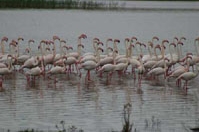 A surprisingly large number of mammals - small and large - use wetlands for habitat or feeding. Hippo's spend their days submerged in rivers, lakes or estuaries, and reedbuck prefer wetlands to dry habitats. Many small mammals such as the swamp musk shrew, the vlei rat, the water mongoose and the spotted-neck otter live close to wetlands, using them as feeding grounds. A surprisingly large number of mammals - small and large - use wetlands for habitat or feeding. Hippo's spend their days submerged in rivers, lakes or estuaries, and reedbuck prefer wetlands to dry habitats. Many small mammals such as the swamp musk shrew, the vlei rat, the water mongoose and the spotted-neck otter live close to wetlands, using them as feeding grounds.
|
|
Wetlands and Floods
Healthy wetlands help to reduce the impact of fast-flowing floods. Because they are generally flatter areas of marshy ground with reeds or other special plants, they force river waters to slow down and spread out. Although much of the destructive impact of floods is related to people building their homes or roads in floodplains or farming too close to rivers and wetlands, the destruction of wetlands has reduced the natural landscape's ability to manage normal spikes in rain or drought cycles.
Palmiet wetlands are good examples of ecosystems that can effectively reduce the impact of floods. Palmiet, also called the superglue of Cape wetland systems, is a unique wetland plant that occurs in association with quartzite. Where palmiet has been removed from wetlands, rivers frequently become highly sedimented and their banks are gouged out by unchecked floodwaters.
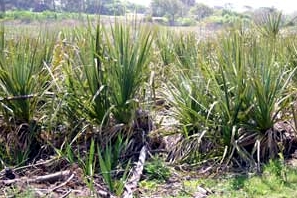
|
|
Food from Wetlands
 In addition to contributing to the life support services that sustain us, wetlands also provide many people with a livelihood, or means of earning a living. Often it is poor people, especially in rural areas, who are most directly dependent on wetlands for at least part of their livelihoods. In addition to contributing to the life support services that sustain us, wetlands also provide many people with a livelihood, or means of earning a living. Often it is poor people, especially in rural areas, who are most directly dependent on wetlands for at least part of their livelihoods.
Good food helps keep people healthy. There are many types of foods that can be harvested from wetlands, both wild and cultivated. In many parts of the world small mammals, aquatic snails, arthropods, insects, reptiles and amphibians are eaten widely. In South Africa, bullfrogs and cane rats are popular eating in many areas, both providing a rich source of protein. Cane rats prefer semi-aquatic environments in marshes and reedbeds.
Fish is probably the most obvious wetland food and is a significant wetland contributor to human health. 21% of animal protein in Africa comes from fish and in South Africa many communities depend on fish from freshwater lakes and rivers as well as estuaries and coastal shores. In Kosi Bay in Maputaland, the estuary is criss-crossed with traditional reed fish kraals which trap large fish as the tide goes out. About 40,000 kg of fish is caught every year in this area, most of it for family consumption, with the surplus sold. Estuaries are also important nurseries and breeding grounds for many economically important sea fish that are captured at sea.
 There are also many edible wetland plants in South Africa. For example, the white, sweet-smelling flowers of waterblommetjies, Aponogeton distachyos, are made into waterblommetjie bredie which is eaten widely in the Western Cape. Another indigenous vegetable is the tuber of the blue water lily, Nymphae nouchali, which is roasted like potato. The rhizomes of bulrushes, Typha capensis, are dried and ground, to be eaten like cereal meal and swamp forests yield various fruits, nuts and leafy vegetables. There are also many edible wetland plants in South Africa. For example, the white, sweet-smelling flowers of waterblommetjies, Aponogeton distachyos, are made into waterblommetjie bredie which is eaten widely in the Western Cape. Another indigenous vegetable is the tuber of the blue water lily, Nymphae nouchali, which is roasted like potato. The rhizomes of bulrushes, Typha capensis, are dried and ground, to be eaten like cereal meal and swamp forests yield various fruits, nuts and leafy vegetables.
|
|
Farming in Wetlands
In many rural communities produce from subsistence agriculture helps ensure that people have adequate nutrition. Vegetables from home gardens, milk from cattle and meat from household chickens and goats are often the most important food for many families.
In places such as Maputaland where the soils are sandy and lack nutrients, the edges of wetlands provide organic-rich, moist soils that are ideal for farming. The same in places like Craigieburn in Mpumalanga where forced resettlement resulted in large numbers of people occupying small areas of land, leaving wetlands as the only sites available for subsistence farming.
Common crops such as cabbages are grown on the edges of wetlands and there are also some plants that are grown in wetter soils, such as amadumbe which is very popular throughout Africa. Its corms are eaten like potatoes and in fact make a much tastier alternative, and its leaves are eaten like spinach.
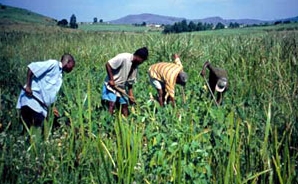
Wetlands provide good, nutritious food for livestock and in fact, some wetlands can provide up to five times more grazing than terrestrial grasslands. However, it is important that wetlands are grazed wisely and that they are protected from overtrampling and degradation.
Many South African wetlands are used sustainably for low-density subsistence agriculture and sensitive grazing but most are not suitable for large-scale agriculture.
|
|
Medicine from Wetlands
In South Africa traditional medicine is the preferred primary health care choice for about 70% of people, and every year 28 million South Africans use about 19,500 tons of medicinal plant material. Wetlands support a great diversity of plant species, some of which are used in traditional medicines.
 The wetlands of the Eastern Cape and KwaZulu-Natal yield the river pumpkin, Gunnera perpensa, which is used to ease childbirth and treat kidney and bladder infections. The leaves of the white arum lily, Zantedeschia aethiopica, which is widespread in wetlands throughout the country, are used to treat headaches and as a poultice. Eucomis comosa, (slender pineapple flower), is used to treat rheumatism, Ranunculus multifidus (common buttercup) is used to treat coughs, headaches, urinary complaints, throat ulcers, wounds and pain, and Manulea parviflora (pepper and salt) is used as a natural enema for children with intestinal disorders. The honey disa, Disa polygonoides, is found along the eastern coastline from the Eastern Cape to Southern Mozambique, and is used to restore the voice after an illness. Urginea macrocentra (poison snake-head) is found in marshy ground near streams and treats roundworm and tapeworm. The wetlands of the Eastern Cape and KwaZulu-Natal yield the river pumpkin, Gunnera perpensa, which is used to ease childbirth and treat kidney and bladder infections. The leaves of the white arum lily, Zantedeschia aethiopica, which is widespread in wetlands throughout the country, are used to treat headaches and as a poultice. Eucomis comosa, (slender pineapple flower), is used to treat rheumatism, Ranunculus multifidus (common buttercup) is used to treat coughs, headaches, urinary complaints, throat ulcers, wounds and pain, and Manulea parviflora (pepper and salt) is used as a natural enema for children with intestinal disorders. The honey disa, Disa polygonoides, is found along the eastern coastline from the Eastern Cape to Southern Mozambique, and is used to restore the voice after an illness. Urginea macrocentra (poison snake-head) is found in marshy ground near streams and treats roundworm and tapeworm.
|
|
Wetlands and Disease
People need clean water to stay healthy, but one fifth of the world's people have no access to clean water and are forced to use dirty water for drinking and sanitation. In South Africa 16 million people have no reticulated sanitation and five million people have no access to potable water. This means that they are vulnerable to diseases associated with polluted water, including diarrhoea, cholera, dysentery, hepatitis A and bilharzia. Worldwide, 3 million people die each year from illnesses caused by contaminated water. Preventable water-borne diseases most affect children under five years old.
Many people who rely on river water cannot afford or are not supplied with purified water. Water quality in rivers is reduced by pollution from mining and industrial processes, agriculture, timber and sewage. Because of the concentration of the pollution and the destruction of water resources such as wetlands, natural systems are unable to cope. But where the pollution concentration is low, the plants, soils and microbes in wetlands help to reduce disease-causing organisms and pollutants.
Wetlands are also a source of water-related diseases. For example, they support mosquitoes that transfer malaria. Draining wetlands may be able to help control malaria in some areas, but many beneficial ecosystem services are lost in the process. It makes better sense to reduce mosquito larvae by making sure that there is a healthy population of the creatures that feed on them.
|
|
Fun in Wetlands
It would be impossible to put a monetary value to the importance of beautiful natural areas for psychological well-being and their contribution to reducing stress levels in people. Wetlands offer delightful open spaces that people can visit to walk, birdwatch or just enjoy being in nature.
 Nearly 20% of the world's people live in cities of one million or more, and urbanisation has increased dramatically over the past 25 years - from 37% to 49% of global population. Outdoor activities such as cycling, walking, boating, fishing, birding and watersports all contribute to improving our lifestyles and mental well-being, and help to stave off mental illnesses such as depression. Nearly 20% of the world's people live in cities of one million or more, and urbanisation has increased dramatically over the past 25 years - from 37% to 49% of global population. Outdoor activities such as cycling, walking, boating, fishing, birding and watersports all contribute to improving our lifestyles and mental well-being, and help to stave off mental illnesses such as depression.
Wetlands such as mangroves and rocky shores are popular for school outings. They are fascinating outdoor classrooms where learners can interact with the elements of the ecosystem and see first hand how they are integrated. And let's face it, there's nothing more fun than squishing your toes in the mud, especially if you're meant to be 'at school'.
|
|
Threatened Wetlands
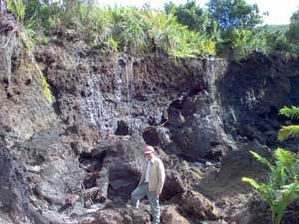 Wetlands are vulnerable to a range of impacts that can reduce their ability to be beneficial. In addition to direct impacts such as draining for pastures and crops or the construction of infrastructure such as roads that impede and concentrate water flow, there are also severe ongoing impacts from pollution and erosion in catchments, excessive water abstraction, loss of vegetation cover, climate change and land use change. In some major catchments, up to 60% of the wetlands are already lost or severely degraded because of mining, agriculture, timber plantations and urban development. Wetlands are vulnerable to a range of impacts that can reduce their ability to be beneficial. In addition to direct impacts such as draining for pastures and crops or the construction of infrastructure such as roads that impede and concentrate water flow, there are also severe ongoing impacts from pollution and erosion in catchments, excessive water abstraction, loss of vegetation cover, climate change and land use change. In some major catchments, up to 60% of the wetlands are already lost or severely degraded because of mining, agriculture, timber plantations and urban development.
Everyone is affected when wetlands are degraded. In urban areas, it might mean reduced water quality, or even a reduced supply, as well as infrastructure loss from more destructive flood impacts. In rural areas, those who rely on wetlands for their livelihoods lose important benefits, and as rural areas degrade, those people are forced to relocate to cities. Many waterbird populations have declined because of wetland degradation. For example, the Wattled crane, which breeds in wetlands during the dry season, is strongly affected by changes to wetland hydrology.
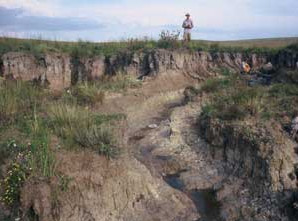 Wetlands in heavily industrialised parts of the country are irreplaceable as water purifiers. For example, the peatlands of the Klip River in southern Johannesburg have absorbed the pollution of 150 years of gold mining in the western Witwatersrand, as well as more recent industrial and urban pollution, resulting in a higher water quality for downstream users than would be the case had there been no wetlands. Degradation of these wetlands not only reduces their ability to purify water, but also results in the release of trapped pollutants. Wetlands in heavily industrialised parts of the country are irreplaceable as water purifiers. For example, the peatlands of the Klip River in southern Johannesburg have absorbed the pollution of 150 years of gold mining in the western Witwatersrand, as well as more recent industrial and urban pollution, resulting in a higher water quality for downstream users than would be the case had there been no wetlands. Degradation of these wetlands not only reduces their ability to purify water, but also results in the release of trapped pollutants.
But degradation is not necessarily permanent, and international and South African experience has shown that it is possible to recover some of the health and values of degraded wetlands through rehabilitation. Legislation of the departments of Environmental Affairs and Tourism, Water Affairs and Forestry, and Agriculture protects wetlands and encourages their rehabilitation.
When a wetland is damaged or degraded it can no longer provide all the goods and services it supplied previously, when it was in good condition. But if it is returned to a healthy state, some or even all of these services can be recovered.
Wetland rehabilitation is the action taken to reverse or halt the decline of the health of the ecosystem.
|
Back
home / about / location / join / contact / calendar / gallery / links / birds / trees / wetlands / biodiversity
|
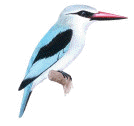

 The health and well-being of people is intricately linked to the state of their environment. For example, their exposure to water-borne diseases is reduced if they have a good, clean water supply - whether from taps or directly from rivers. There are many such benefits, or ecosystem services, that nature provides that are essential to human health and well-being. But to be able to provide these services, ecosystems need to be kept in a healthy condition. As an ecosystem becomes degraded, or less healthy, the services it supplies are usually reduced. Ecosystem services operate on such a vast scale and in such complex ways that most cannot be replaced by human technology. The health and well-being of people therefore depends on maintaining healthy ecosystems.
The health and well-being of people is intricately linked to the state of their environment. For example, their exposure to water-borne diseases is reduced if they have a good, clean water supply - whether from taps or directly from rivers. There are many such benefits, or ecosystem services, that nature provides that are essential to human health and well-being. But to be able to provide these services, ecosystems need to be kept in a healthy condition. As an ecosystem becomes degraded, or less healthy, the services it supplies are usually reduced. Ecosystem services operate on such a vast scale and in such complex ways that most cannot be replaced by human technology. The health and well-being of people therefore depends on maintaining healthy ecosystems. In providing these ecosystem services, healthy wetlands play an important role in keeping people healthy. If we protect healthy wetlands to keep them in a good condition, and rehabilitate those that have been degraded, we can avoid much suffering due to droughts, floods and compromised livelihoods, especially for the most vulnerable members of society.
In providing these ecosystem services, healthy wetlands play an important role in keeping people healthy. If we protect healthy wetlands to keep them in a good condition, and rehabilitate those that have been degraded, we can avoid much suffering due to droughts, floods and compromised livelihoods, especially for the most vulnerable members of society. When we assess a person's health, we think of several interconnected systems - e.g. a skeleton and a circulatory system. So if we want to describe the health of a person, we assess how well each of these systems is performing. We can assess wetlands in the same way if we think of them as being made up of different systems. We can think of the geomorphological system - sand, clay and underlying rock - as the bones and muscles of the wetland. The hydrological system - the water - would be the circulatory system or lifeblood of the wetland. And the vegetation is the skin and hair protecting the wetland. We can assess each of these systems to determine the overall health of the wetland. We also need to ask what is causing the decline in a degraded wetland so that we can improve its condition in a way that addresses both the symptoms and the causes.
When we assess a person's health, we think of several interconnected systems - e.g. a skeleton and a circulatory system. So if we want to describe the health of a person, we assess how well each of these systems is performing. We can assess wetlands in the same way if we think of them as being made up of different systems. We can think of the geomorphological system - sand, clay and underlying rock - as the bones and muscles of the wetland. The hydrological system - the water - would be the circulatory system or lifeblood of the wetland. And the vegetation is the skin and hair protecting the wetland. We can assess each of these systems to determine the overall health of the wetland. We also need to ask what is causing the decline in a degraded wetland so that we can improve its condition in a way that addresses both the symptoms and the causes. 
 Wetlands are warehouses of biodiversity. They support plants and animals that are specially adapted to wetlands and can live nowhere else, and also provide feeding, roosting and breeding sites for a range of other species. Even in urban areas they are important refuges for small mammals, birds and amphibians.
Wetlands are warehouses of biodiversity. They support plants and animals that are specially adapted to wetlands and can live nowhere else, and also provide feeding, roosting and breeding sites for a range of other species. Even in urban areas they are important refuges for small mammals, birds and amphibians. A surprisingly large number of mammals - small and large - use wetlands for habitat or feeding. Hippo's spend their days submerged in rivers, lakes or estuaries, and reedbuck prefer wetlands to dry habitats. Many small mammals such as the swamp musk shrew, the vlei rat, the water mongoose and the spotted-neck otter live close to wetlands, using them as feeding grounds.
A surprisingly large number of mammals - small and large - use wetlands for habitat or feeding. Hippo's spend their days submerged in rivers, lakes or estuaries, and reedbuck prefer wetlands to dry habitats. Many small mammals such as the swamp musk shrew, the vlei rat, the water mongoose and the spotted-neck otter live close to wetlands, using them as feeding grounds.
 In addition to contributing to the life support services that sustain us, wetlands also provide many people with a livelihood, or means of earning a living. Often it is poor people, especially in rural areas, who are most directly dependent on wetlands for at least part of their livelihoods.
In addition to contributing to the life support services that sustain us, wetlands also provide many people with a livelihood, or means of earning a living. Often it is poor people, especially in rural areas, who are most directly dependent on wetlands for at least part of their livelihoods. There are also many edible wetland plants in South Africa. For example, the white, sweet-smelling flowers of waterblommetjies,
There are also many edible wetland plants in South Africa. For example, the white, sweet-smelling flowers of waterblommetjies, 
 The wetlands of the Eastern Cape and KwaZulu-Natal yield the river pumpkin,
The wetlands of the Eastern Cape and KwaZulu-Natal yield the river pumpkin,  Nearly 20% of the world's people live in cities of one million or more, and urbanisation has increased dramatically over the past 25 years - from 37% to 49% of global population. Outdoor activities such as cycling, walking, boating, fishing, birding and watersports all contribute to improving our lifestyles and mental well-being, and help to stave off mental illnesses such as depression.
Nearly 20% of the world's people live in cities of one million or more, and urbanisation has increased dramatically over the past 25 years - from 37% to 49% of global population. Outdoor activities such as cycling, walking, boating, fishing, birding and watersports all contribute to improving our lifestyles and mental well-being, and help to stave off mental illnesses such as depression. Wetlands are vulnerable to a range of impacts that can reduce their ability to be beneficial. In addition to direct impacts such as draining for pastures and crops or the construction of infrastructure such as roads that impede and concentrate water flow, there are also severe ongoing impacts from pollution and erosion in catchments, excessive water abstraction, loss of vegetation cover, climate change and land use change. In some major catchments, up to 60% of the wetlands are already lost or severely degraded because of mining, agriculture, timber plantations and urban development.
Wetlands are vulnerable to a range of impacts that can reduce their ability to be beneficial. In addition to direct impacts such as draining for pastures and crops or the construction of infrastructure such as roads that impede and concentrate water flow, there are also severe ongoing impacts from pollution and erosion in catchments, excessive water abstraction, loss of vegetation cover, climate change and land use change. In some major catchments, up to 60% of the wetlands are already lost or severely degraded because of mining, agriculture, timber plantations and urban development. Wetlands in heavily industrialised parts of the country are irreplaceable as water purifiers. For example, the peatlands of the Klip River in southern Johannesburg have absorbed the pollution of 150 years of gold mining in the western Witwatersrand, as well as more recent industrial and urban pollution, resulting in a higher water quality for downstream users than would be the case had there been no wetlands. Degradation of these wetlands not only reduces their ability to purify water, but also results in the release of trapped pollutants.
Wetlands in heavily industrialised parts of the country are irreplaceable as water purifiers. For example, the peatlands of the Klip River in southern Johannesburg have absorbed the pollution of 150 years of gold mining in the western Witwatersrand, as well as more recent industrial and urban pollution, resulting in a higher water quality for downstream users than would be the case had there been no wetlands. Degradation of these wetlands not only reduces their ability to purify water, but also results in the release of trapped pollutants.